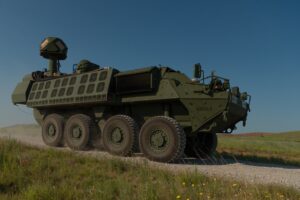HUNTSVILLE, Ala. — Following a slight delay in the delivery of the first prototypes, the Army’s Directed Energy Maneuver Short-Range Air Defense (DE M-SHORAD) program to field a Stryker-mounted 50-kilowatt laser system is headed for a user assessment in early fiscal year 2024.
Lt. Gen. Robert Rasch, director of the Army’s Rapid Capabilities and Critical Technologies Office (RCCTO), confirmed details of the program timeline to Defense Daily
and said DE M-SHORAD could potentially transition into a program of record and a competitive effort for production around FY ‘25 or ‘26.

“That’s the beauty of prototyping is that we learn a lot sooner than having invested in a full-up program of record. We’re learning so much more. We’re helping industry to learn as well as Army leaders learn on how directed energy is going to fit on the battlefield. So we’ll continue to do that. But the [FY] ‘25/’26 timeframe is when I would expect a decision on the transition of that into a traditional program of record,” Rasch said during an interview Thursday at the Association of the United States Army’s Global Force Symposium here.
The RCCTO-led DE M-SHORAD program aims to deliver an on-the-move laser system capable of taking down unmanned aerial systems, rotary-wing aircraft and rockets, artillery and mortars.
Currently, the program is focused on a prototyping effort with Kord Technologies providing the 50-kilowatt laser system and Raytheon Technologies [RTX] serving as the laser module integrator.
Rasch noted the Army received the first DE M-SHORAD for testing in November, adding that initial training on the system was completed in January and was “very positive.”
“We completed that training with some live fire testing with the soldiers out at Yuma Proving Ground [in Arizona]. It was a great event. The soldiers were very excited. The soldiers have been a part of our development for the last couple of years on this and they see the marked improvement of that capability,” Rasch said.
The Army anticipates all DE M-SHORAD prototypes to be delivered by the third quarter of this fiscal year, according to Rasch.
“And then it’s time to learn. We’re starting to learn what are the [tactics, techniques and procedures] for directed energy systems on the battlefield. What’s the mix of DE M-SHORAD and kinetic M-SHORAD? And how will we fight those as part of our formations?” Rasch said. “Then we’ll go back to the Army and lay out here’s the breadth of capabilities that we have, where should the Army invest? We chose 50-kilowatts because the systems at the time and the modeling at the time said this is the right area. But 50-kilowatt comes at a price.”
Initial DE M-SHORAD prototypes were expected to be delivered in September, but Rasch noted there was a slight delay primarily due to “integration of subcomponents.”
“When you look at all of the subcomponents, they’re relatively mature systems but we’re using them in different ways. And the integration of those took a little bit longer than we thought,” Rasch told Defense Daily.
Rasch said as prototype deliveries are completed RCCTO will continue development testing ahead of the larger user assessment later this year.
“We’re learning more about things like reliability and system performance. And soldiers will be a part of that as well making sure the system is absolutely meeting the requirements or making sure that we have the requirements right for that capability,” Rasch said.
Leading into the user assessment in early FY ‘24, Rasch added the Army plans to focus on developing tactics, techniques and procedures, or TTPs, for operating DE M-SHORAD.
“The [user assessment] in the first quarter [of FY ‘24] will be basically the testing of how well they can fight it. So it’s a step-by-step approach; getting the equipment, do the initial testing, let them develop TTPs, do that operational assessment on the back end and then help provide the data back to inform future Army decisions. Meanwhile, RCCTO will continue to do prototyping to work with industry to find out how to make these more producible,” Rasch said.
Rasch said the directed energy space still has a “nascent industrial base,” with RCCTO focusing on lowering costs as the Army looks to field new capabilities.
“We need affordable directed energy. So part of my effort at RCCTO is not just to get a prototype out for this capability but also to try to ensure we understand what are the price points and where can the government help with industry investments to make them cheaper over time,” Rasch told Defense Daily. “We’re trying to figure out how to help them mature that along so we can get directed energy systems at scale and affordable as part of this mix.”
Following the DE M-SHORAD prototyping effort, RCCTO is expected to transition the program to the Army’s Program Executive Office for Missiles and Space, which would oversee the potential competition for production.
Lockheed Martin [RTX] has previously detailed its Directed Energy Interceptor for the Maneuver Short-Range Air Defense System (DEIMOS) system that it’s looking to offer for the future DE M-SHORAD competition, achieving “first light” of its 50-kilowatt laser capability in January (Defense Daily, Jan. 23).